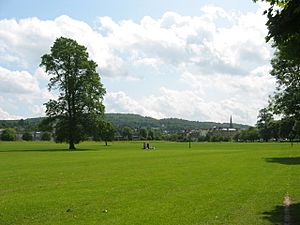Battle of the North Inch facts for kids
Quick facts for kids Battle of the North Inch |
|||||||
|---|---|---|---|---|---|---|---|
| Part of Clan Cameron-Clan Mackintosh feud | |||||||
 Perth's North Inch in modern times, looking southeast towards the city's eastern edge. |
|||||||
|
|||||||
| Belligerents | |||||||
| Chattan Confederation or Clan Mackintosh | "Clan Quhele" (Camerons or Davidsons?) | ||||||
| Strength | |||||||
| 30 men | 30 men | ||||||
| Casualties and losses | |||||||
| 19 dead | 29 dead | ||||||
The Battle of the North Inch (also known as the Battle of the Clans) was a very unusual fight that happened in September 1396. It wasn't a huge war, but a special "staged battle" between two Scottish clans. Thirty men from each side were chosen to fight in front of King Robert III of Scotland and many other people.
This unique event took place on a field called the North Inch in Perth, Scotland. The Clan Chattan won the battle, but it was a tough fight. They lost 19 men, while almost all of their opponents were killed. Historians are still not completely sure who the other clan, called "Clan Quhele," really was. It might have been their old rivals, Clan Cameron, or perhaps Clan Davidson.
Contents
Why Did the Battle of the Clans Happen?
Scottish clans often had disagreements and fought each other. The Clan Cameron and the Clan Chattan (especially the Mackintoshes within Clan Chattan) had been feuding for a long time. They had even fought a big battle before, around 1370 or 1386.
King Robert III wanted to stop these endless fights. He asked important leaders like David Lindsay, 1st Earl of Crawford to help the clans make peace. But they couldn't agree on a solution.
So, the clan chiefs came up with a daring idea: a "trial by combat." This meant picking a small group of warriors from each side to fight it out. The king agreed to this plan. He promised to honor the winners and forgive the losing side, hoping it would finally end the feud.
How Was the Battle Fought?
The clans agreed to fight on a Monday, just before a special day called Michaelmas. The earliest stories say that 30 men were chosen for each side. To make sure no one interfered, barriers were built around the fighting area on the North Inch.
King Robert III and his court watched from a special platform. The warriors were armed with traditional Scottish weapons. These included swords, round shields called targes, bows and arrows, knives, and heavy battle-axes.
Just as the fight was about to begin, something unexpected happened. One of the Clan Chattan warriors became sick. This meant the numbers were no longer even. It was suggested that the other clan should also remove one man.
But then, a brave man named Henry Wynd (also known as Henry Smith) stepped forward. He was a skilled swordsman and offered to fight for Clan Chattan if he survived. He asked for a payment, and his offer was accepted.
The battle then began. It was a very violent and bloody fight. According to one account, 19 men from Clan Chattan died. On the other side, 29 of their opponents were killed.
What Happened After the Battle?
Most stories agree that only 11 men from Clan Chattan survived the battle. This included Henry Wynd, the volunteer. Only one warrior from the opposing clan survived. When he realized he was the last one, he bravely jumped into the River Tay and swam to safety.
Henry Wynd, the swordsman who helped Clan Chattan win, was invited to join their clan. Many people from the Clan Chattan's Gow or Smith sept are said to be his descendants.
Even after this dramatic battle, the feud between Clan Cameron and Clan Chattan didn't completely end. They fought each other again many years later, in 1429, at the Battle of Palm Sunday.
Images for kids
-
This is a type of Claymore sword, similar to those used in the battle.
-
Henry Smith (left) and a Highlander in Walter Scott's The Fair Maid of Perth.
See also
- Combat of the Thirty, a similar battle that happened in Brittany in 1351.



